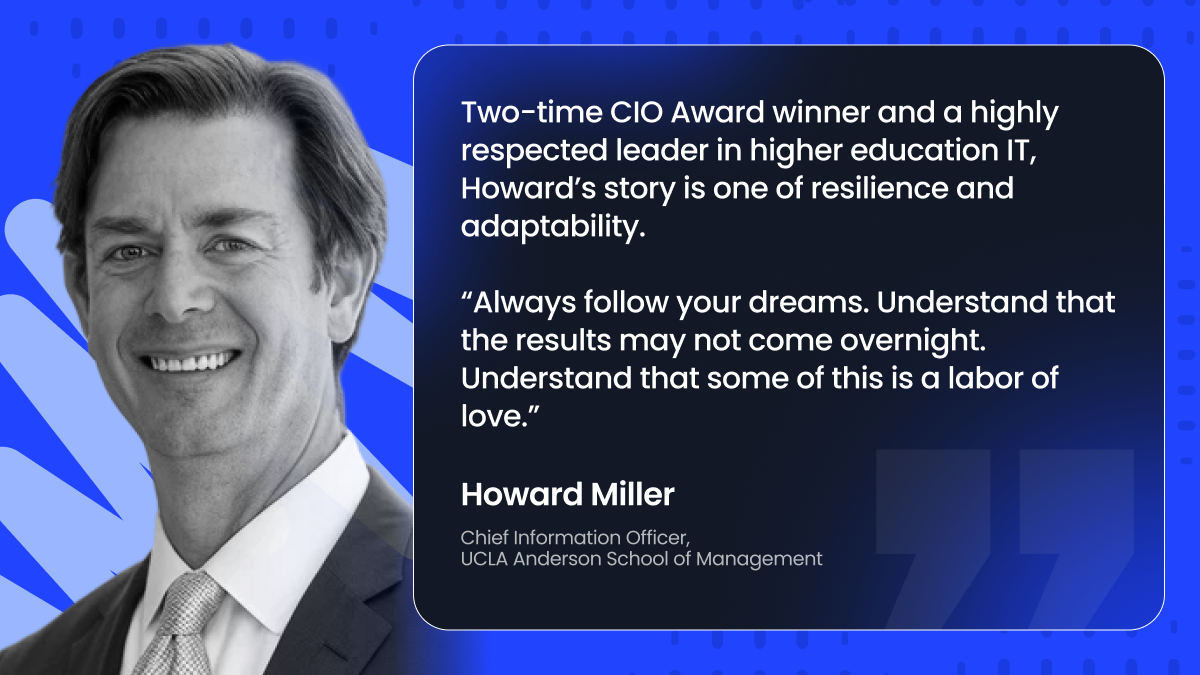HIPAA Compliance Checklist for 2025

In this episode, Nidhi Jain, CEO of CloudEagle, sits down with Howard Miller, Chief Information Officer at UCLA Anderson School of Management. With more than 35 years of experience in IT leadership across manufacturing, pharmaceuticals, and higher education, Howard shares his remarkable journey from entry-level programmer to award-winning CIO.
He offers candid advice on career pivots, the evolving role of IT, and the importance of aligning technology with business strategy in today’s academic world.

Leadership, Cost Optimization, and Innovation in Higher Education IT
The Evolving Role of the CIO in Higher Education
Reflecting on his career, Howard highlights how the CIO role has transformed.
“Fifteen years ago, the CIO had to be the smartest technical person in the room. Today, it’s about hiring great technical teams and focusing on how technology can enable business strategy.”
This shift means CIOs must be business enablers, aligning IT initiatives with institutional goals and ensuring technology delivers real value to students and faculty. Howard emphasizes that technical awareness is still essential, but the real measure of success is how well IT supports and advances the organization’s mission.
Security and Cost Optimization
As higher education faces new challenges, security and cost optimization have become central themes for IT leaders. When Howard first joined UCLA Anderson, only half of one employee’s time was dedicated to security. Today, his security team has grown to four full-time staff.
This investment shows how vital information security has become. It is not just for compliance, but to protect identities, institutional reputation, and sensitive data in an increasingly digital world.
“Security is paramount for any business,” Howard notes, “but in higher ed, where openness and collaboration are fundamental, the challenge is even greater.”
He explains that the open, collaborative nature of academia often makes traditional security models counterintuitive, requiring a careful balance between accessibility and protection. Keep reading to see how Howard handled major hurdles with a thoughtful approach.
Open-by-Design Challenges in Universities
Universities are “open by design,” encouraging collaboration and knowledge sharing. But this openness brings unique security challenges. Balancing accessibility with robust security frameworks is a daily challenge for higher ed IT leaders.
“Our security model is sort of counterintuitive to what you would have in any other business, just because it’s designed to be open based on the collaborative nature of education.”
Navigating the Budget Squeeze
Like many educational institutions, UCLA Anderson faces intense budget scrutiny in the post-COVID times. The financial situation in higher education was tough. Fewer students were enrolling, and every dollar spent was being closely watched.
“Budgets are under more scrutiny than ever. It’s been the toughest financial stretch I’ve faced. I had to reevaluate every spend and see what’s truly necessary,” Howard says.
For Howard, this meant closely reviewing every contract, every application, and every single expense. “With more SaaS apps and remote work than ever, it's become really important to keep track of who’s using what, and how much it all costs,” Howard says. He wanted to ensure that every investment in technology and security was delivering real, measurable value.
Embracing AI and Automation in Academia
Howard Miller’s journey with AI started long before it made the headlines. It began years earlier, with a simple but powerful idea - make technology work for people, not the other way around. When he was at Columbia Business School, Howard took a leap by implementing a Moveworks conversational chatbot for IT service management.
“I was using LLMs before I even knew what an LLM really was. I had bought a conversational chatbot for IT service management and that was sort of my first real introduction to this type of technology.”
What excited Howard most was the way automation and self-service could change the daily experience for everyone on campus. “It allows people to self-serve, which seems to be an important thing in this era. People want to be able to get answers as quickly as possible.” He saw that staff didn’t have to do repetitive tasks like resetting passwords or software provisioning.
UCLA Anderson’s AI-First Approach
The real turning point came with the rise of generative AI like ChatGPT. Instead of resisting, UCLA Anderson leaned in.
“We went all in and we said we are going to be AI-first. We’re encouraging the use of AI and we are trying to figure out where we can deliver the technology to enhance the academic mission better.”
This AI-first approach is not just about adopting new tools, it’s about reimagining how technology can support teaching, learning, and operations across the institution. To ensure accuracy and minimize risks like hallucinations, Howard’s team builds AI applications trained exclusively on UCLA Anderson’s own data. This ensured the results were accurate and useful.
Building High-Performance IT Teams
Behind every successful IT initiative is a strong, collaborative team. Howard believes in hiring technically skilled professionals and empowering them to drive innovation. He stresses the importance of trust, development, and collective success.
Key Takeaways:
- The CIO role in higher education is evolving from technical expert to strategic business partner.
- Security and cost optimization are top priorities, especially as institutions face financial scrutiny and complex security challenges.
- AI and automation are transforming academic operations, enabling self-service and improving efficiency.
- Building high-performance IT teams requires trust, development, and a shared commitment to the institution’s mission.
- Embracing innovation and training staff and students in responsible AI usage is critical for academic success.
Summing it all up,
UCLA Anderson’s journey under Howard Miller’s leadership is proof that IT, when guided by vision and adaptability, can be a true driver of innovation, security, and cost efficiency in higher ed. Howard’s story reminds us that aligning technology with institutional goals, investing in continuous learning, and embracing responsible AI adoption are what empower universities to thrive.
.jpg)
%201.svg)








.avif)




.avif)
.avif)




.png)









